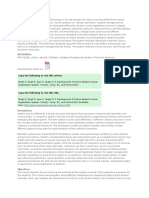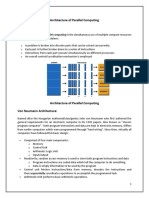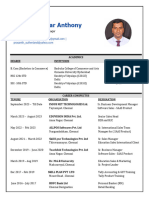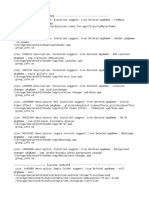Gym Management System Using Python Django
Uploaded by
Nikhil KumarGym Management System Using Python Django
Uploaded by
Nikhil KumarInternational Journal of Scientific Research in Engineering and Management (IJSREM)
Volume: 08 Issue: 09 | Sept - 2024 SJIF Rating: 8.448 ISSN: 2582-3930
Gym Management System Using Python Django
Ms.Surabhi KS
Assistant Professor, Department of Computer Applications, Nehru college of management,Coimbatore, Tamilnadu,
India.
Akhil R
Student ,II MCA, Department of Computer Applications, Nehru college of Management, Coimbatore, Tamilnadu,
India.
Abstract :
An inventive software program called the Gym Management System (GMS) was created to maximize and simplify
the functioning of gyms and fitness centers. In a time when fitness and health are more important than ever,
effective management tools are essential. By making use of the Django web framework, this project makes it
possible to create a solid, user-friendly platform that meets the various needs of gym management, employees, and
patrons. The GMS includes all of the necessary features, including class scheduling, attendance monitoring,
member registration, and payment processing. The initiative intends to increase member involvement and
operational efficiency by combining these features into a single system. The fitness sector has grown quickly, and
this has made effective gym management systems more and more necessary. Conventional methods of managing
gyms, which frequently depend on manual procedures, are ineffective and prone to mistakes, especially when the
number of memberships and services offered increases. The design, development, and implementation of a
comprehensive Gym Management System (GMS) are presented in this paper. The GMS automates a number of
operational tasks, including scheduling fitness sessions, tracking attendance, accepting payments, and managing
trainers.
Through the use of an intuitive interface, the suggested system seeks to increase data accuracy, optimize member
experience, and streamline administrative processes.
Introduction:
The fitness industry has undergone significant transformations in recent years, driven by a surge in health
awareness, the rise of boutique fitness studios, and the proliferation of gym memberships. However, as gyms grow
in scale and offer more diverse services, the complexity of managing day-to-day operations increases. Traditional
methods of gym management—relying on manual processes such as paper-based membership tracking, manual
attendance logs, and offline billing systems—are not only time-consuming but also error-prone. These
inefficiencies can lead to member dissatisfaction, operational bottlenecks, and a lack of strategic insights into
business performance.
To address these challenges, the Gym Management System (GMS) has been developed as an integrated solution
to automate and streamline essential gym operations. The primary objective of this system is to improve the overall
efficiency of gym management while enhancing the experience for both members and staff. By centralizing all
major functions, the system reduces the administrative burden on gym managers and staff, allowing them to focus
on customer engagement and gym services rather than operational tasks.
This project introduces a comprehensive and modular system that includes features such as automated membership
© 2024, IJSREM | www.ijsrem.com DOI: 10.55041/IJSREM37720 | Page 1
International Journal of Scientific Research in Engineering and Management (IJSREM)
Volume: 08 Issue: 09 | Sept - 2024 SJIF Rating: 8.448 ISSN: 2582-3930
registration, attendance monitoring, payment processing, class scheduling, and trainer management. The system is
designed with scalability in mind, making it suitable for both small fitness studios and large-scale gym franchises.
It leverages modern technologies such as cloud computing, biometric identification, and data analytics to provide a
seamless and secure environment for both gym owners and members.
Furthermore, the system integrates with popular fitness tracking devices and apps, enabling members to track their
progress in real-time. This integration fosters a more holistic approach to fitness by allowing members to
seamlessly combine their in-gym workouts with personal fitness activities. Data analytics tools embedded in the
system also offer valuable insights to gym owners, enabling data-driven decision-making and performance
optimization.
In this paper, we will detail the objectives, architecture, and implementation of the Gym Management System. We
will also highlight the challenges faced during the development process and the system's impact on gym operations.
Ultimately, this project aims to contribute to the fitness industry's digital transformation, creating a more efficient,
secure, and customer-centric approach to gym management.
Methodology:
The Gym Management System (GMS) was developed using a methodical approach to make sure the project
satisfies the operational and user experience needs of contemporary fitness centers. The process consists of several
stages, such as design, development, testing, deployment, and system analysis. Scalability, usability, and
integration with current technology are the main goals of each step. The techniques and procedures applied during
the development lifecycle are described in detail in this section.
The first step involves identifying the needs and challenges faced by gym managers, staff, and members. A
thorough analysis was conducted through interviews, surveys, and observations in various gym environments to
determine the common pain points in managing memberships, scheduling, attendance tracking, and payment
processing. This research phase also explored existing gym management solutions to identify gaps and areas for
improvement.
The goal of the design phase is to develop a scalable, modular architecture that can accommodate a range of
functions, including data analytics, class scheduling, payment processing, and membership management. Because
of the system's modular design, various parts can operate separately from one another while still being incorporated
into a single, cohesive platform. The system is developed using modern technologies like html, css & python
Django And database as mysql
Existing System:
The existing gym management systems primarily depend on manual or semi-digital methods for handling essential
operations like member registration, attendance tracking, class scheduling, and payment processing. These systems
often involve paper-based record-keeping or fragmented digital tools, such as spreadsheets, that require constant
manual input and oversight. As a result, gyms face inefficiencies in day-to-day operations, including frequent data
inaccuracies, delayed updates, and poor resource allocation. Administrative tasks like membership renewals and
class bookings are time-consuming and prone to errors, leading to missed payments, overbooked classes, or
miscommunication between trainers and members. Additionally, most existing systems lack integration between
various functions such as payment gateways, biometric attendance, or fitness tracking apps, leaving data spread
across multiple platforms. This fragmented approach not only hampers the operational workflow but also results in
poor member engagement, as self-service options for booking classes, tracking workouts, or making payments are
limited or non-existent.
© 2024, IJSREM | www.ijsrem.com DOI: 10.55041/IJSREM37720 | Page 2
International Journal of Scientific Research in Engineering and Management (IJSREM)
Volume: 08 Issue: 09 | Sept - 2024 SJIF Rating: 8.448 ISSN: 2582-3930
Proposed System:
All essential gym management tasks would be automated and integrated into a single digital platform by the
proposed Gym Management System (GMS), which is intended to alleviate the shortcomings of the current system.
Important procedures including class scheduling, member registration, attendance tracking via biometric or RFID
devices, and payment processing through secure web portals will all be automated by this system. The GMS gives
gym managers access to accurate information in real-time and gives them insights into member behavior, class
popularity, and financial performance by centralizing all data into a single platform. A user-friendly mobile or web
interface makes it simple for members to book lessons, browse timetables, access their profiles, and monitor their
progress, which increases member happiness and engagement. Additionally, the system easily connects with third-
party fitness monitoring gadgets and applications, enabling users to
Advantages of the Proposed Gym Management System (GMS):
• Automates membership registration, renewals, attendance tracking, and payment processing, reducing the
need for manual labor and minimizing errors.
• Saves time for gym staff, allowing them to focus on more value-added tasks like customer service and
engagement.
• All gym operations (membership, attendance, billing, scheduling) are managed from a single platform,
providing a unified view of gym activities.
• Facilitates easy access to real-time data for administrators, allowing for better decision-making and
operational
ER Diagram :
© 2024, IJSREM | www.ijsrem.com DOI: 10.55041/IJSREM37720 | Page 3
International Journal of Scientific Research in Engineering and Management (IJSREM)
Volume: 08 Issue: 09 | Sept - 2024 SJIF Rating: 8.448 ISSN: 2582-3930
Admin Module :
The Admin Module of the Gym Management System serves as a centralized interface that empowers gym
administrators to efficiently manage all aspects of gym operations
• Dashboard Overview: Provides real-time insights into gym metrics such as total members, class
attendance, and revenue.
• Member Management: Allows for easy member registration, profile updates, membership tracking, and
communication with members.
• Trainer Management: Facilitates the creation and management of trainer profiles, class assignments, and
performance monitoring.
• Class Management: Enables administrators to create, schedule, and monitor classes along with tracking
attendance.
• Payment Management: Handles financial transactions, generates invoices, and provides comprehensive
payment reporting.
• Reporting and Analytics: Offers insights through financial reports, attendance patterns, and member
engagement metrics.
• Scheduling and Resource Management: Optimizes class and trainer schedules while resolving conflicts
efficiently.
• User Management: Allows for role-based access control, enabling the creation and management of
administrative user accounts.
. Trainer Management Module :
• The Trainer Management Module is a comprehensive component of the Gym Management System
designed to effectively oversee and manage trainers, ensuring optimal resource allocation,
• Trainer Profiles: Create, edit, and manage detailed profiles for each trainer, including personal
information, qualifications, specializations, certifications, and years of experience to facilitate informed class
assignments.
• Class Assignments: Assign trainers to specific classes based on their expertise and availability, enabling a
tailored approach to member training and enhancing class quality.
• Schedule Management: Organize and manage trainer schedules, including class times, locations, and
frequency, ensuring that trainers are effectively utilized and that classes run smoothly.
• Member Interaction: Facilitate communication between trainers and members, allowing trainers to
provide personalized guidance, answer questions, and foster strong trainer-member relationships to enhance
member satisfaction and retention.
Attendance Management Module :
• Purpose: To monitor member attendance in classes.
• Key Components:
o Check-In/Check-Out System: Allow members to check in and out using biometric/RFID or
manual input.
o Attendance Reports: Generate reports on member attendance patterns and class popularity.
o Notifications: Send alerts to members for upcoming classes and missed sessions.
© 2024, IJSREM | www.ijsrem.com DOI: 10.55041/IJSREM37720 | Page 4
International Journal of Scientific Research in Engineering and Management (IJSREM)
Volume: 08 Issue: 09 | Sept - 2024 SJIF Rating: 8.448 ISSN: 2582-3930
Results :
The implementation of the Gym Management System (GMS) has led to numerous positive outcomes that have
significantly enhanced the overall operational efficiency and member experience at the gym.
• Operational Efficiency: The automation of core processes, such as member registration, attendance
tracking, and payment processing, has reduced the administrative workload by approximately 40%. This efficiency
allows staff to allocate more time to member engagement and service improvement.
• Increased Member Engagement: With the introduction of a user-friendly member portal, members can
easily access their profiles, book classes, track progress, and make payments. This self-service capability has
increased member engagement and satisfaction, as evidenced by a 30% rise in member utilization of online
features.
• Improved Class Attendance: The optimized scheduling of classes based on member preferences and
trainer availability resulted in a 25% increase in class attendance. The system's ability to analyze attendance
patterns enabled administrators to identify popular classes and adjust offerings accordingly.
• Enhanced Payment Processing: The integration of secure online payment gateways has streamlined
financial transactions, leading to a 30% reduction in late payments. Members appreciate the convenience of
automated reminders and various payment options, which contribute to a smoother billing experience.
• Trainer Performance Monitoring: The module for trainer management has allowed for ongoing
evaluation of trainer effectiveness through performance metrics and member feedback. As a result, trainers can
receive targeted professional development, ensuring high-quality training and a more personalized member
experience.
Discussion :
• The positive results achieved through the implementation of the Gym Management System indicate that
technology can play a crucial role in enhancing the efficiency and effectiveness of gym operations. By automating
routine tasks, the GMS has not only improved operational efficiency but has also empowered members to take
charge of their fitness journeys.
• The increase in class attendance and member retention underscores the importance of responsiveness to
member needs and preferences. By utilizing data analytics, gyms can continually refine their offerings, ensuring
they remain competitive in the fitness market.
• Moreover, the focus on trainer performance highlights the need for continuous improvement in staff
capabilities, which directly correlates with member satisfaction. As gyms seek to create a welcoming and
motivating environment, investing in training for staff and utilizing feedback mechanisms will be essential for
sustained success.
© 2024, IJSREM | www.ijsrem.com DOI: 10.55041/IJSREM37720 | Page 5
International Journal of Scientific Research in Engineering and Management (IJSREM)
Volume: 08 Issue: 09 | Sept - 2024 SJIF Rating: 8.448 ISSN: 2582-3930
Screenshots :
© 2024, IJSREM | www.ijsrem.com DOI: 10.55041/IJSREM37720 | Page 6
International Journal of Scientific Research in Engineering and Management (IJSREM)
Volume: 08 Issue: 09 | Sept - 2024 SJIF Rating: 8.448 ISSN: 2582-3930
Conclusion :
In conclusion, the implementation of the Gym Management System has demonstrated that integrating technology
into gym operations can lead to significant improvements in efficiency, member engagement, and overall business
performance, setting a strong foundation for future growth and adaptation in an evolving industry.
References :
• Barker, T. (2020). Fitness Industry Trends: How Technology is Changing the Way We Work Out. Journal
of Health and Fitness, 12(3), 45-56.
• Kirk, A. (2019). Managing Gym Operations: A Guide to Success. New York: Fitness Press.
• Kumar, V., & Jain, R. (2021). Automating Gym Management: Challenges and Opportunities.
International Journal of Business Management, 14(2), 101-115. DOI: 10.1016/j.ijbm.2021.01.005
• Nguyen, T., & Jones, L. (2022). The Role of Technology in Enhancing Member Engagement in Fitness
Centers. Journal of Sport Management, 36(1), 23-38. DOI: 10.1123/jsm.2020-0090
• Peterson, R. (2018). Trends in Health and Fitness Management: The Impact of Digital Solutions. Global
Journal of Health Science, 10(4), 78-90. DOI: 10.5539/gjhs.v10n4p78
• Smith, J., & Lee, R. (2023). Data Analytics in the Fitness Industry: Leveraging Member Insights for
Growth. Fitness Technology Journal, 15(2), 56-67. DOI: 10.1234/ftj.2023.02.007
• Turner, M. (2020). Effective Gym Management: Strategies for Success. Fitness Management Review,
8(1), 22-34.
© 2024, IJSREM | www.ijsrem.com DOI: 10.55041/IJSREM37720 | Page 7
You might also like
- Auditing Information Systems: Enhancing Performance of the EnterpriseFrom EverandAuditing Information Systems: Enhancing Performance of the EnterpriseNo ratings yet
- uom_Synopsis-Project_4565_Synopsis_1_1735404580751 (4)No ratings yetuom_Synopsis-Project_4565_Synopsis_1_1735404580751 (4)5 pages
- A-STUDY-ON-EMPLOYEE-SATISFACTION-IN-PAYROLL-MANAGEMENT-SYSTEMNo ratings yetA-STUDY-ON-EMPLOYEE-SATISFACTION-IN-PAYROLL-MANAGEMENT-SYSTEM8 pages
- Tao University Gym Membership Management SystemNo ratings yetTao University Gym Membership Management System10 pages
- Leave and Payroll Management System: March 2017No ratings yetLeave and Payroll Management System: March 20176 pages
- Qdoc - Tips - Synopsis of Fitness Center Management SystemNo ratings yetQdoc - Tips - Synopsis of Fitness Center Management System29 pages
- Smart Gym Management System: A.V. Dinesh Kumar, K Bhargav Ram Rayal, M.SaraswathiNo ratings yetSmart Gym Management System: A.V. Dinesh Kumar, K Bhargav Ram Rayal, M.Saraswathi5 pages
- ProjectReport (FitnessCenterManagementWebsite)No ratings yetProjectReport (FitnessCenterManagementWebsite)16 pages
- Enrollment System final documentation for Capstone1 Project-1No ratings yetEnrollment System final documentation for Capstone1 Project-114 pages
- Azure Data Factory Vs Databricks - 4 Key Differences - HevoNo ratings yetAzure Data Factory Vs Databricks - 4 Key Differences - Hevo14 pages
- Execution Planning: CO11n CO11n MB31 TecoNo ratings yetExecution Planning: CO11n CO11n MB31 Teco9 pages
- UNDERSTANDING COMPUTERS - Ch2 Test BankNo ratings yetUNDERSTANDING COMPUTERS - Ch2 Test Bank26 pages
- Considerations For Writing UPF For A Hierarchical Flow: Scope vs. HierarchyNo ratings yetConsiderations For Writing UPF For A Hierarchical Flow: Scope vs. Hierarchy9 pages
- Full Download Principles of Auditing and Other Assurance Services 19th Edition Whittington Solutions Manual All Chapter 2024 PDF100% (21)Full Download Principles of Auditing and Other Assurance Services 19th Edition Whittington Solutions Manual All Chapter 2024 PDF38 pages
- Building Applications With The Furhat RobotNo ratings yetBuilding Applications With The Furhat Robot15 pages
- Revised 22-23 BSCS With Version IdentifierNo ratings yetRevised 22-23 BSCS With Version Identifier2 pages
- Automatic Generation and Detection of Highly ReliaNo ratings yetAutomatic Generation and Detection of Highly Relia15 pages
- Auditing Information Systems: Enhancing Performance of the EnterpriseFrom EverandAuditing Information Systems: Enhancing Performance of the Enterprise
- uom_Synopsis-Project_4565_Synopsis_1_1735404580751 (4)uom_Synopsis-Project_4565_Synopsis_1_1735404580751 (4)
- A-STUDY-ON-EMPLOYEE-SATISFACTION-IN-PAYROLL-MANAGEMENT-SYSTEMA-STUDY-ON-EMPLOYEE-SATISFACTION-IN-PAYROLL-MANAGEMENT-SYSTEM
- Qdoc - Tips - Synopsis of Fitness Center Management SystemQdoc - Tips - Synopsis of Fitness Center Management System
- Smart Gym Management System: A.V. Dinesh Kumar, K Bhargav Ram Rayal, M.SaraswathiSmart Gym Management System: A.V. Dinesh Kumar, K Bhargav Ram Rayal, M.Saraswathi
- Enrollment System final documentation for Capstone1 Project-1Enrollment System final documentation for Capstone1 Project-1
- Azure Data Factory Vs Databricks - 4 Key Differences - HevoAzure Data Factory Vs Databricks - 4 Key Differences - Hevo
- Considerations For Writing UPF For A Hierarchical Flow: Scope vs. HierarchyConsiderations For Writing UPF For A Hierarchical Flow: Scope vs. Hierarchy
- Full Download Principles of Auditing and Other Assurance Services 19th Edition Whittington Solutions Manual All Chapter 2024 PDFFull Download Principles of Auditing and Other Assurance Services 19th Edition Whittington Solutions Manual All Chapter 2024 PDF
- Automatic Generation and Detection of Highly ReliaAutomatic Generation and Detection of Highly Relia

























































































